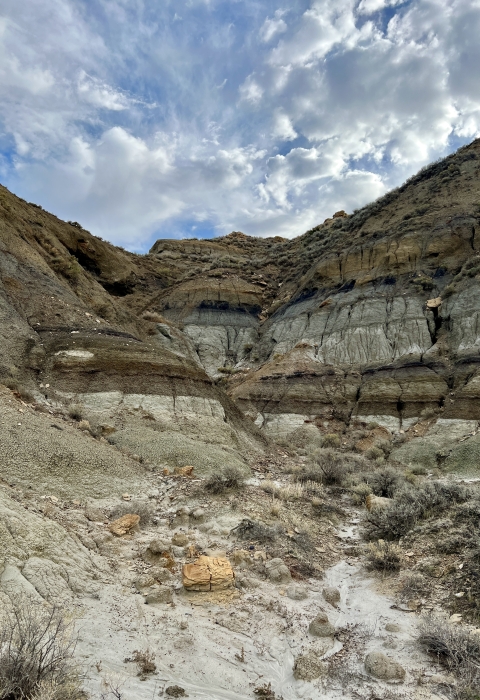On an early October day, we set out for the badlands on the east side of Charles M. Russell National Wildlife Refuge in search of fossils. In eastern Montana a warm fall day can quickly fade into snow that can blanket the ground until the next spring. Faced with the urgency of the season we needed to act fast.
Twenty years earlier a hunter, possibly facing the same sense of urgency to beat the weather, stumbled across not one but two large fossils. He snapped some photos and continued on his way, later reporting his discoveries to a paleontologist. The paleontologist told the hunter that without GPS coordinates the fossils would be almost impossible to find. Not to be deterred, the hunter returned to the Refuge the following year, found both fossils again, took more photos, this time with a tape measure for scale, and collected GPS points. He forwarded this information to the paleontologist but never heard anything about his discoveries.
In spring of 2023 the hunter was visiting the Refuge again. He contacted Refuge staff, curious about whether the fossils he found had been excavated. Not only had the fossils not been excavated but Refuge staff had never heard anything about them. Armed with printouts of the hunter’s original emails to the paleontologist, we wandered into the badlands.
The photos were grainy, but we knew we were looking for a long fossil embedded in a sandstone hillside. We navigated close to the coordinates and looked around. Almost immediately we noticed a hill that looked very similar to the one in the photo. But we did not see the fossil.
Grayish brown rocks were scattered across the ground, their colors seamlessly blending into the sandy surface.However, one small rock, about two inches across, stood out. It was more red than gray and in the middle was a nearly white bone-like structure structure
Something temporarily or permanently constructed, built, or placed; and constructed of natural or manufactured parts including, but not limited to, a building, shed, cabin, porch, bridge, walkway, stair steps, sign, landing, platform, dock, rack, fence, telecommunication device, antennae, fish cleaning table, satellite dish/mount, or well head.
Learn more about structure . Could this be a fossil? While we are confident in our abilities to identify birds or prairie plants; rocks, and certainly fossils, are outside our expertise. “I think you have to lick it. If it sticks to your tongue, it’s a fossil” Paula told us. We laughed but she insisted that was a tried-and-true field test. Sure enough, she was right.
We were excited, we had found a fossil! But it was nowhere near the size of the one in the photo. We continued to search and quickly noticed larger rocks that contained similar formations. There was a large oblong rock sticking out of the hillside and a closer look revealed bones jutting out of its surface. This was not the same fossil from the photograph, but we were clearly in the right area.
In the badlands, landscape features that formed over millions of years can be washed away in a heavy summer rain. In the twenty years since the hunter first located the fossil this part of the Refuge has experienced record-breaking rainfall, record-breaking snowfall, and record-breaking drought. At some point, the hunter’s fossil eroded out from hillside and was likely buried under the sand that came down with it. The fossils we found may have come from the same individual or they could be from a different species entirely.
Mule deer, white-tailed deer, elk, and pronghorn roam freely across more than 1.1 million acres at CMR. Centered in the Refuge is Fort Peck Lake, a reservoir on the Missouri River. The river and lake act as an oasis for wildlife in the rough and rugged terrain of Eastern Montana. But 70 million years ago, another body of water drew wildlife species to this area. Tyrannosaurs rex, edmontosaurus, struthiomimus, and triceratops lived and died on the shores of the ancient inland sea. Mosasaurs and elasmosaurus swam below its surface.
When an animal dies it is usually scavenged by other animals. However, when conditions are right it may avoid becoming someone else’s lunch and turn into a fossil instead. First, it must die in or near water. Then, it must be covered in sediment while its skeleton is still relatively intact. Bones are porous so they absorb the minerals from the wet sediment like a sponge. Eventually all the cells in the bones are filled with minerals while the cell walls remain intact. Over time, more sediment accumulates on top which increases the pressure on the mineral-logged skeleton, hardening it into rock. Fossils, which are usually discovered when the layers of sediment erode, are still porous. Which is why they will stick to your tongue if you are brave enough to lick one.
Although we did not find exactly what we were looking for at the first spot, there was still another fossil to find. We knew from the hunter’s photographs we were looking for an intact bone at least three feet long with what appeared to be a joint at one end and it was lying on the surface of cracked soil. We would need to venture further to find the second fossil. The badlands of CMR are otherworldly. Rock formations spring up out of seemingly nowhere and give way to valleys of sandstone. We climbed up and over these steep formations, watching a herd of mule deer watching us.
As we zeroed in on our second set of coordinates, we saw what was clearly a fossil lying on the ground just where it should be. However, this one was small and broken. We compared it to the photographs and decided what we saw on the ground was likely the end of the bone found by the hunter. A look around the area yielded some smaller, scattered fragments. What took millions of years to be buried deep underground, form into a fossil, and surface again, was nearly unrecognizable after 20 years.
We made our way back to the truck, excited in our newfound fossil identification skills but slightly disappointed that we did not find exactly what we were looking for. Twenty years is not even a blink in the life of a fossil, but it is plenty of time for it to disappear. Perhaps with more time and more erosion, some of the fossils we were looking for will be revealed again.
If you stumble across any fossils while recreating on CMR do not move them. It is illegal to remove fossils and resources like shed antlers or archaeological artifacts from the Refuge and Fort Peck Lake. Think you found something significant on the Refuge? We want to know about it! Please take pictures and GPS coordinates, if you can, and send them to cmr@fws.gov. Please don’t wait twenty years to share!



